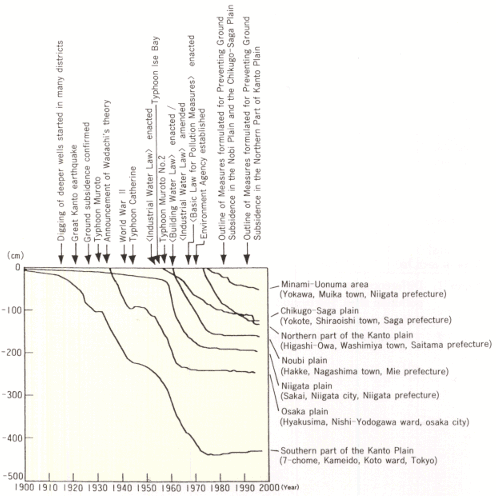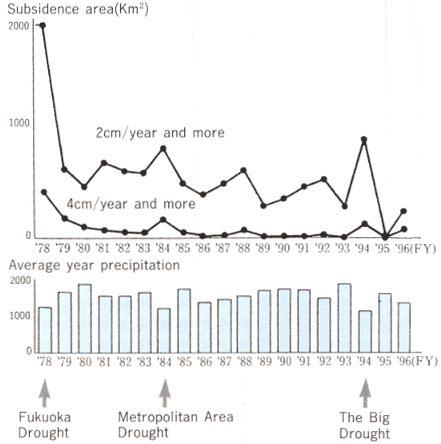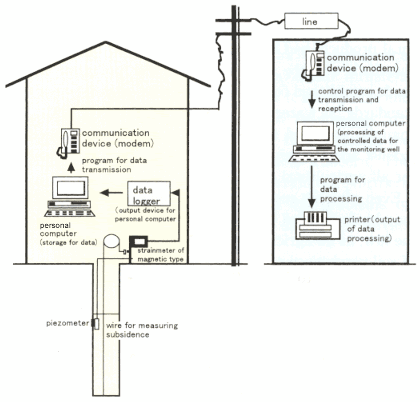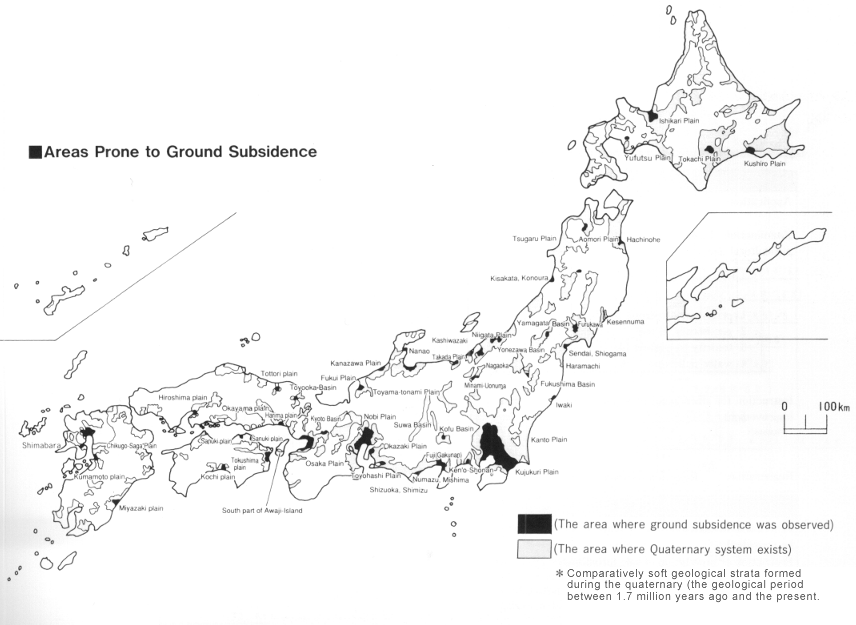Water / Soil / Ground Environment
Conservation of Ground Environment
Excessive pumping of groundwater from soft ground causes ground subsidence. Once subsided, the ground does not return to its original level.
1. History of Ground Subsidence
Ground subsidence was first identified in Tokyo's Koto Ward in the 1910s and in Osaka in the 1920s. It caused destruction to buildings and damages from floods and high tides, raising public concern. World War II disrupted industrial activities and greatly reduced the industrial use of groundwater around 1945, thereby halting ground subsidence. However, subsidence began again in the 1950s, particularly in the metropolitan areas, when the industries revived and the groundwater demand increased rapidly.
Countermeasures against ground subsidence, e.g. controlling the rate of groundwater pumping, were taken in the 1960s. Thereafter, the rate of subsidence in the metropolitan areas has slowed down.
However, some regions still pump large amount of groundwater for drinking, agriculture, snow melting, and industrial use. At present, marked ground subsidence is seen, among other sites, in the suburbs of Tokyo (e. g. the northern part of the Kanto Plain), rural regions (e. g. the Chikugo-Saga Plain) and in snowy regions (e. g. Minami-Uonuma in Niigata Prefecture).
2. Countermeasures against Ground Subsidence
The progressive damage caused by ground subsidence made the public realized that it was necessary to control the pumping up of groundwater to solve the problem. Two laws have been enacted and enforced to reduce the yields of groundwater. The "Industrial Water Law" and the "Law Concerning the Regulation of Pumping-up of Underground Water for Use in Buildings" were enacted in 1956 and 1962, respectively. At present, parts of ten prefectures are regulated under the former law and parts of four prefectures are regulated under the latter. Aside from these laws, local governments formulated ordinances to control the pumping up of groundwater. Industries also carry out voluntary measures to reduce and rationalize groundwater use.
Construction projects have been carried out to supply additional surface water in order to reduce the demand for groundwater.
In the greatly subsided areas, buildings damaged by ground subsidence have been repaired and structures have been erected to prevent damage by floods and high tides.
In order to implement comprehensive countermeasures in the greatly subsided areas (see map), the "Outline of Measures for Preventing Ground Subsidence" was established by the council of concerned Ministers for the Nobi Plain, Chikugo-Saga Plain, and the northern part of the Kanto Plain. The measures stipulate limits to the total yields of groundwater and promote other options such as obtaining water from alternative sources.
Policy-making in the future shall take into account groundwater, springs, as well as the whole ground environment.
It is stated in the Basic Environment Plan as follows:
The government shall promote measures to conserve the ground environment, through preventing ground subsidence and maintaining environmentally sound underground water circulation.
Secular Changes in Ground Subsidence in Typical Areas

In 1994, when almost the whole nation was suffering from drought, ground subsidence became intensified in areas such as the northern part of Kanto Plain, Chikugo and Saga Plains. To monitor the rapid drop in the groundwater level at the time of drought and to evaluate the need for installing telemeter system to upgrade the real-time monitoring of groundwater level, the Environment Agency established observation stations at several monitoring wells on Chikugo and Saga Plains (Saga Prefecture) and at the northern part of Kanto Plain (Saitama Prefecture).
Relationship between Subsidence Areas and the Amounts of Annual Precipitation

Source: Water Resources Department of National Land Agency, "Water Resources White Paper"
Average year precipitation means the average value of 461 sites calculated based on materials of the Meteorological Agency.
Image of Telemeter System

Areas Prone to Ground Subsidence

*Comparatively soft geological strata formed during the quaternary (the geological period between 1.7 million years ago and the present.